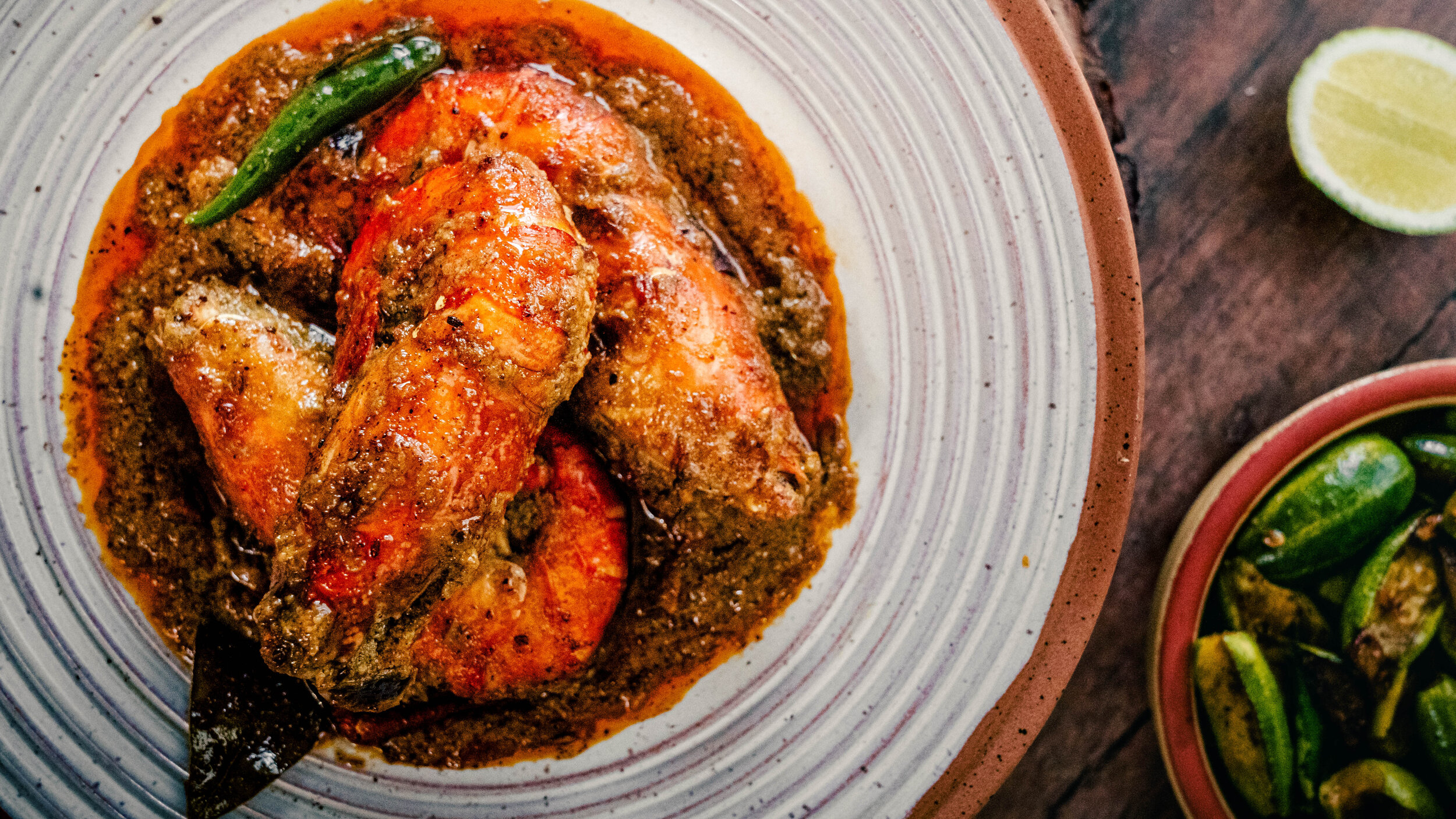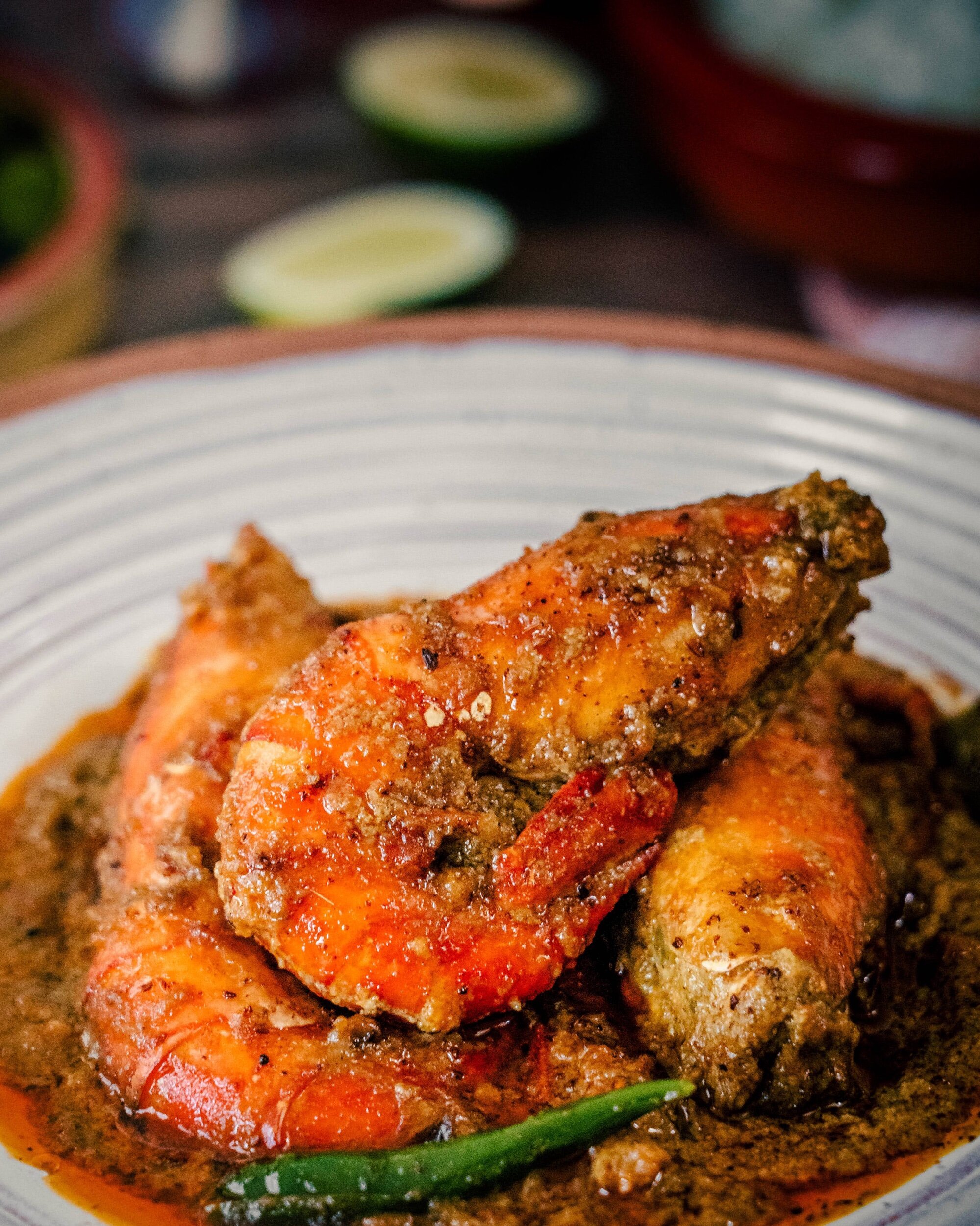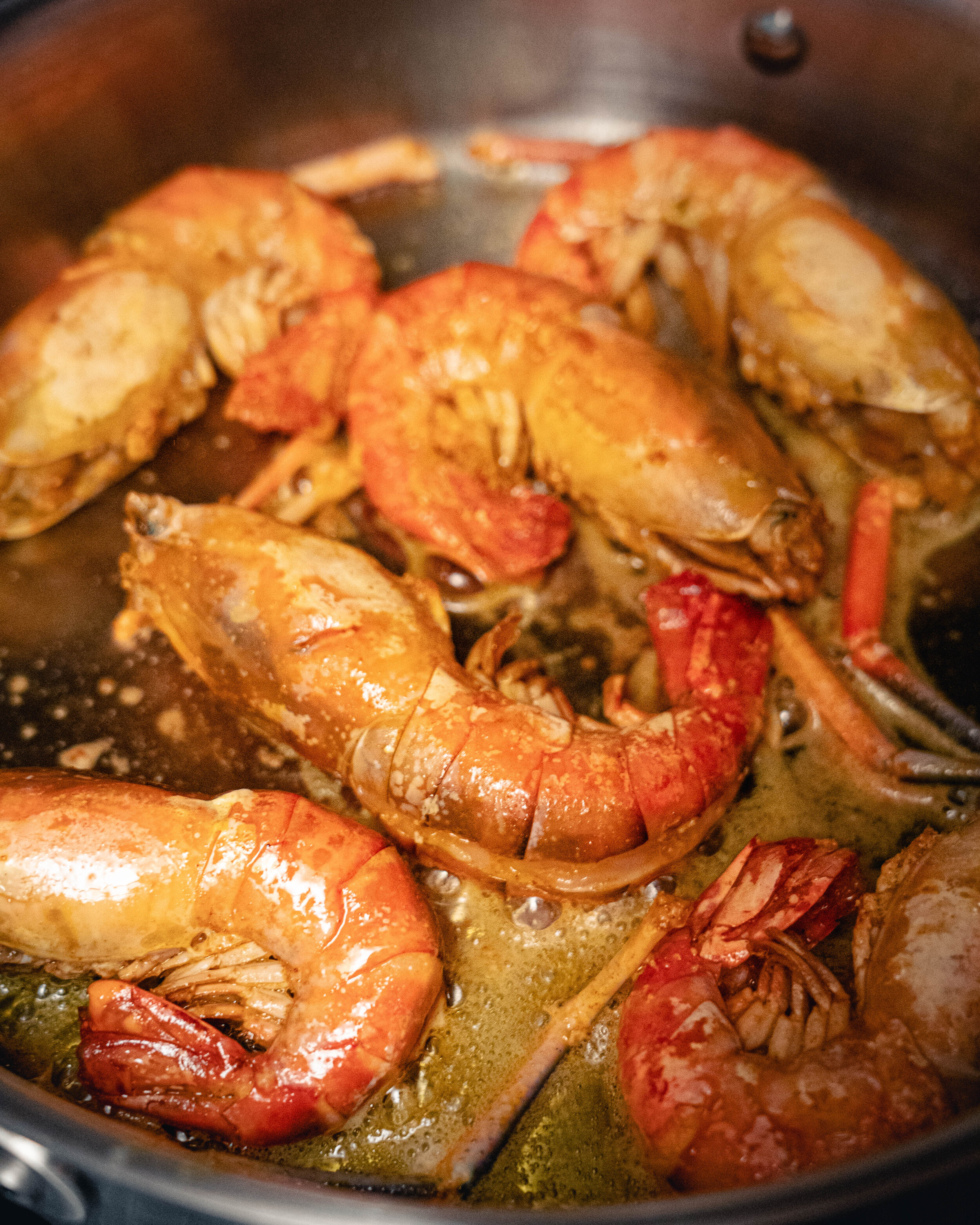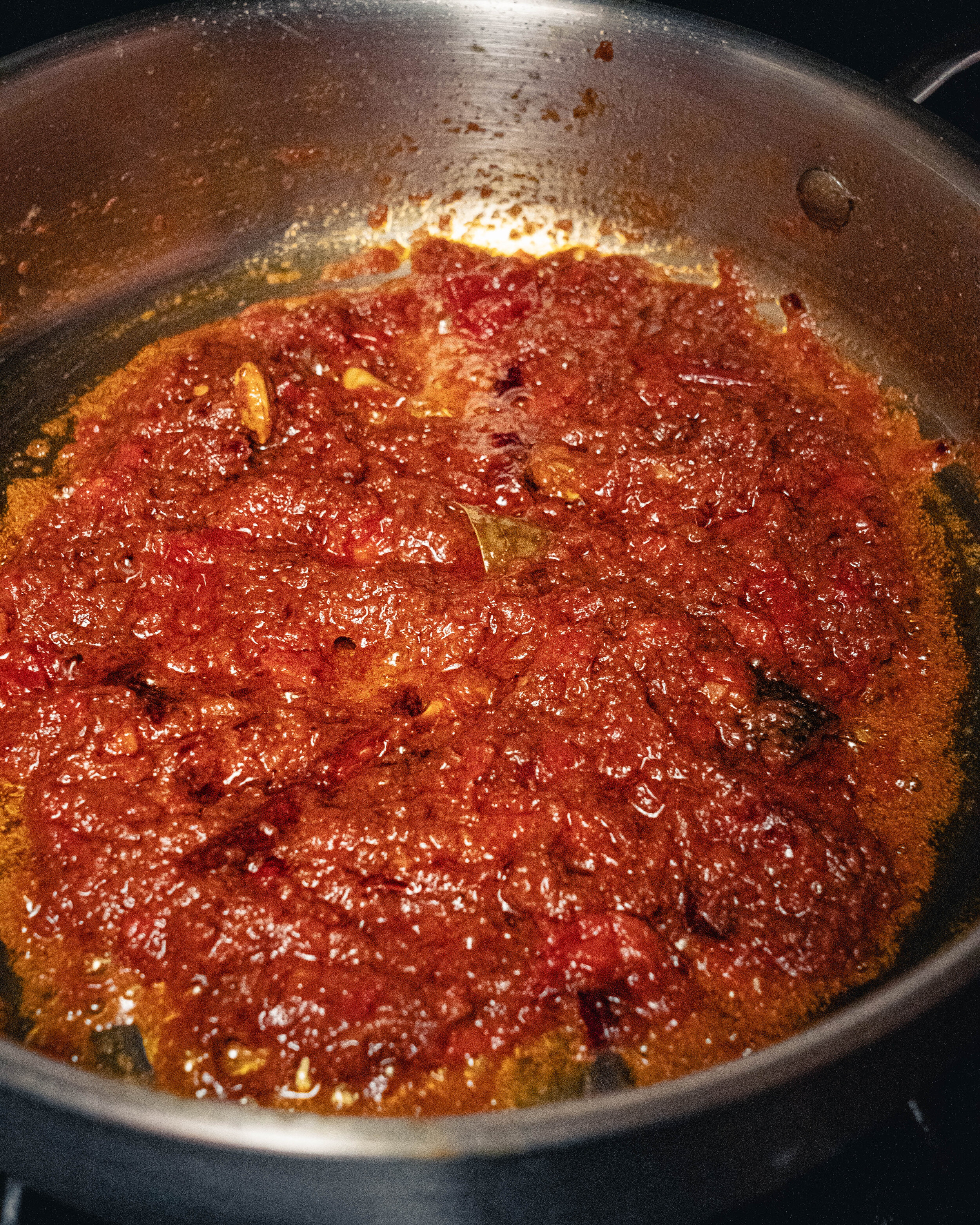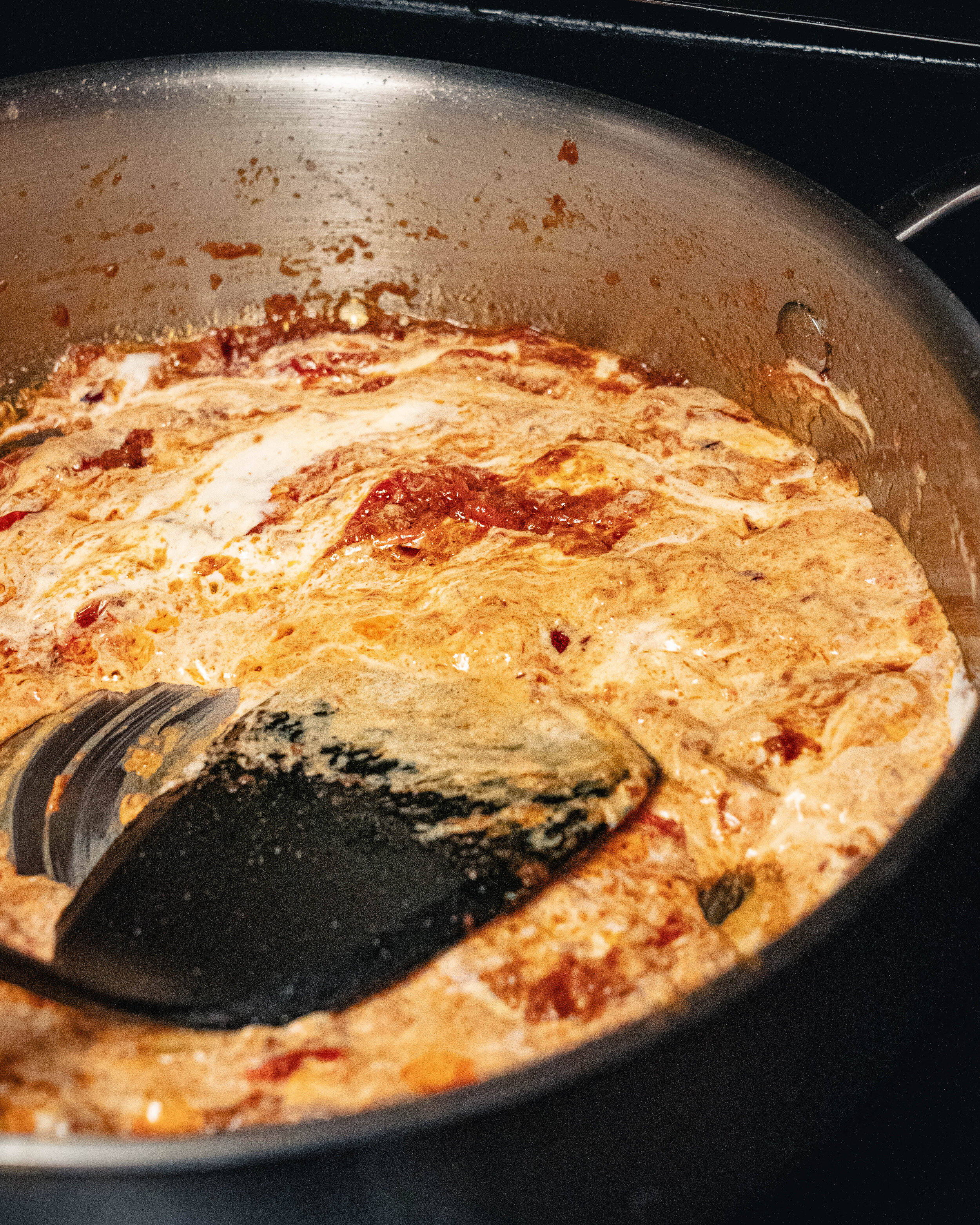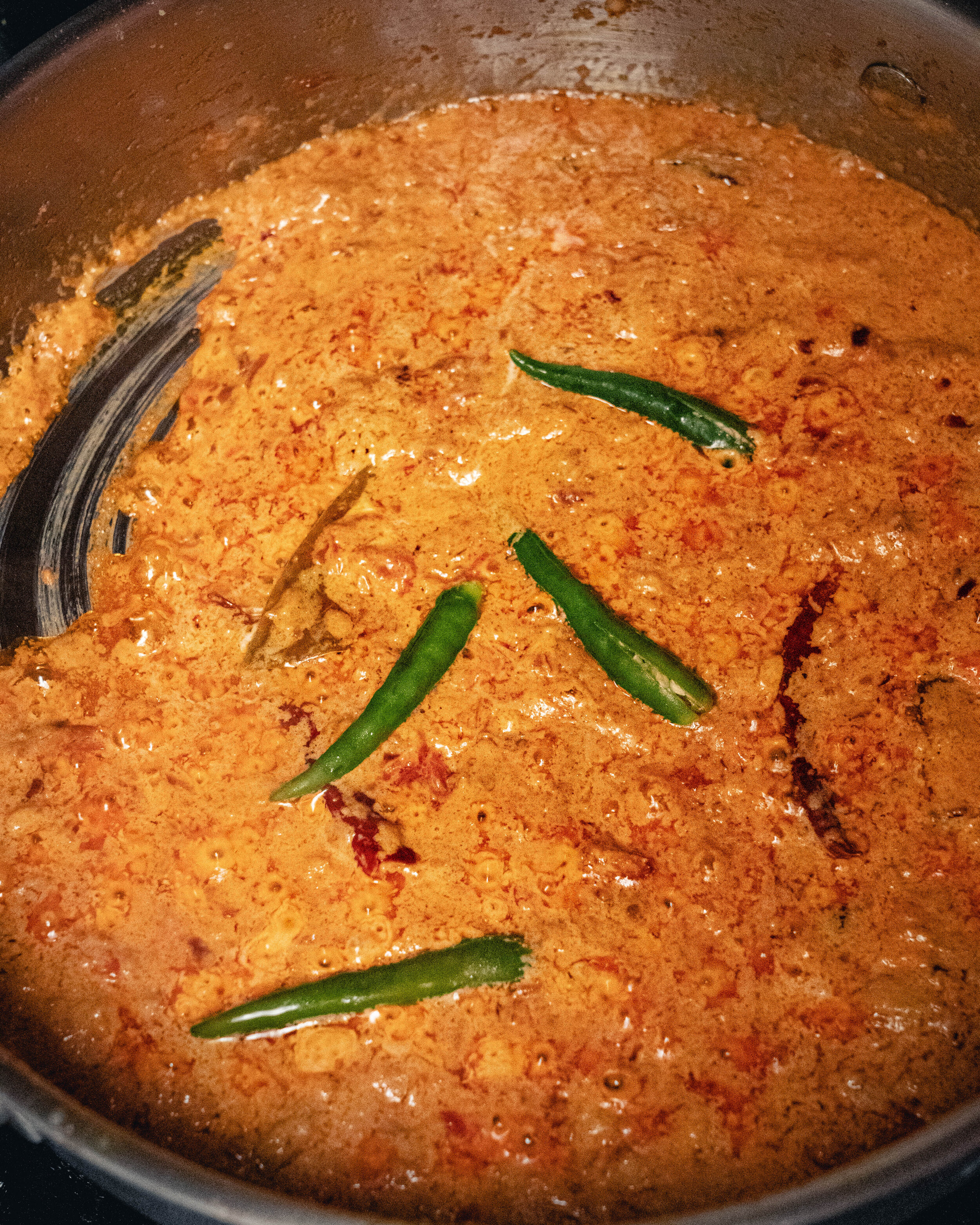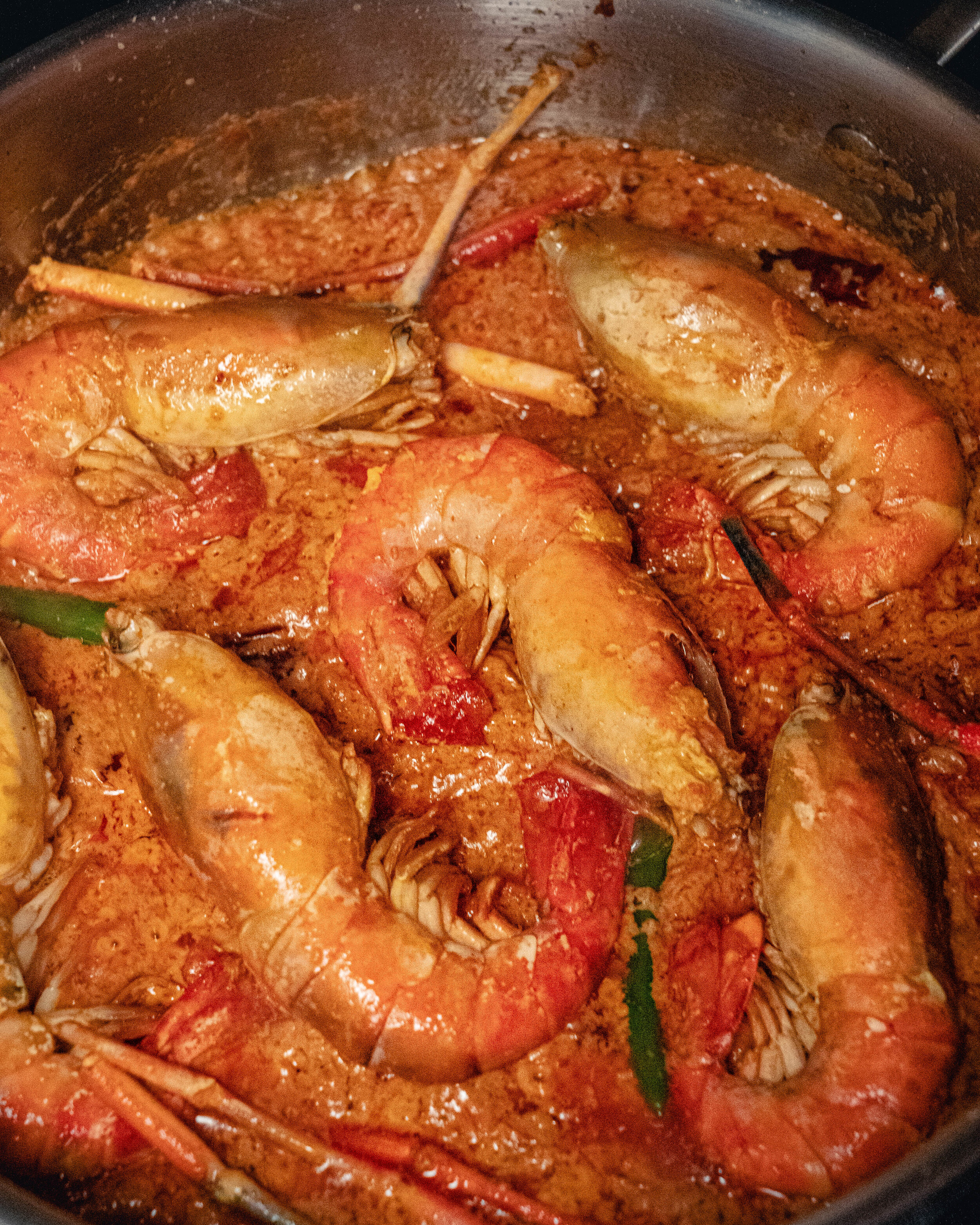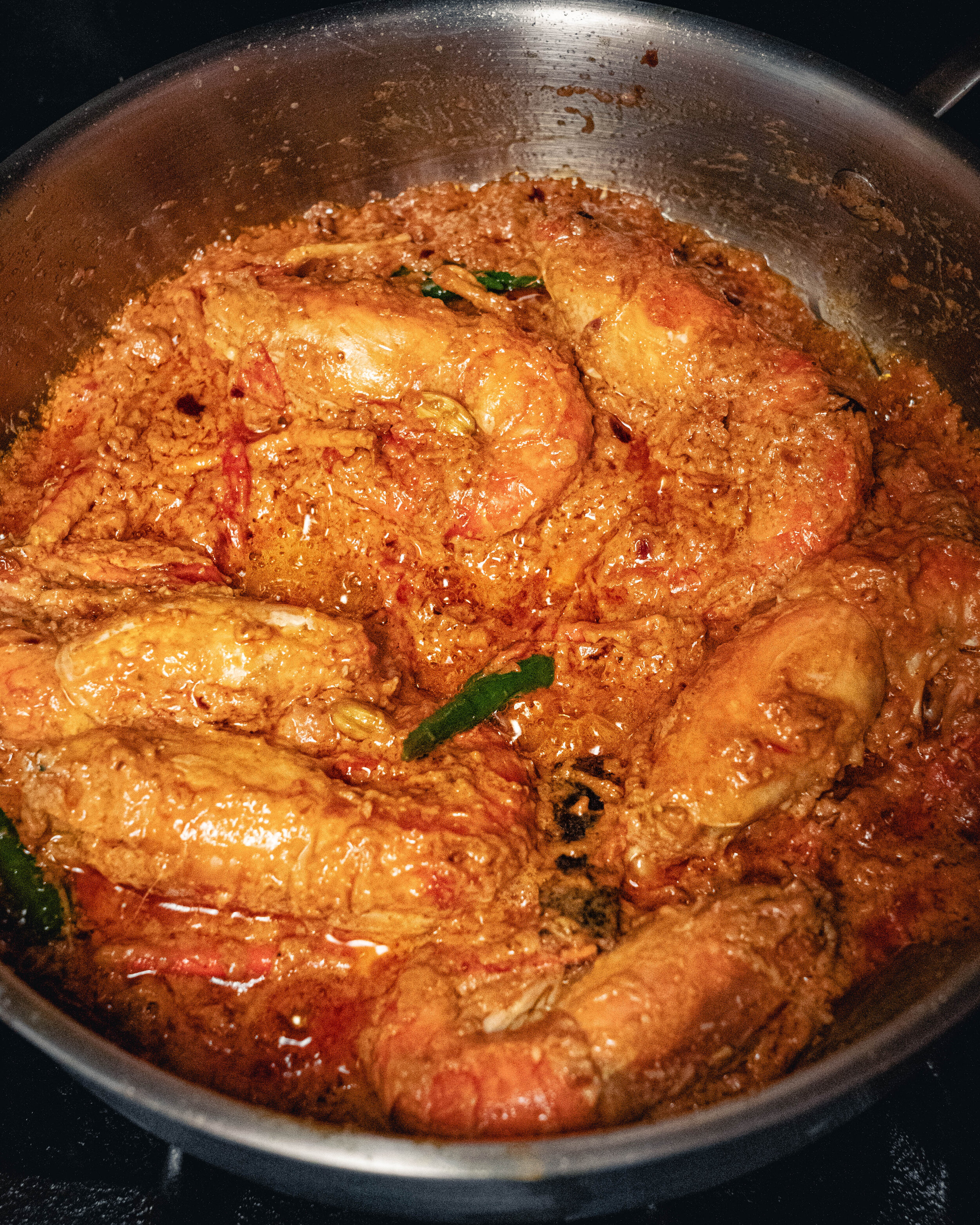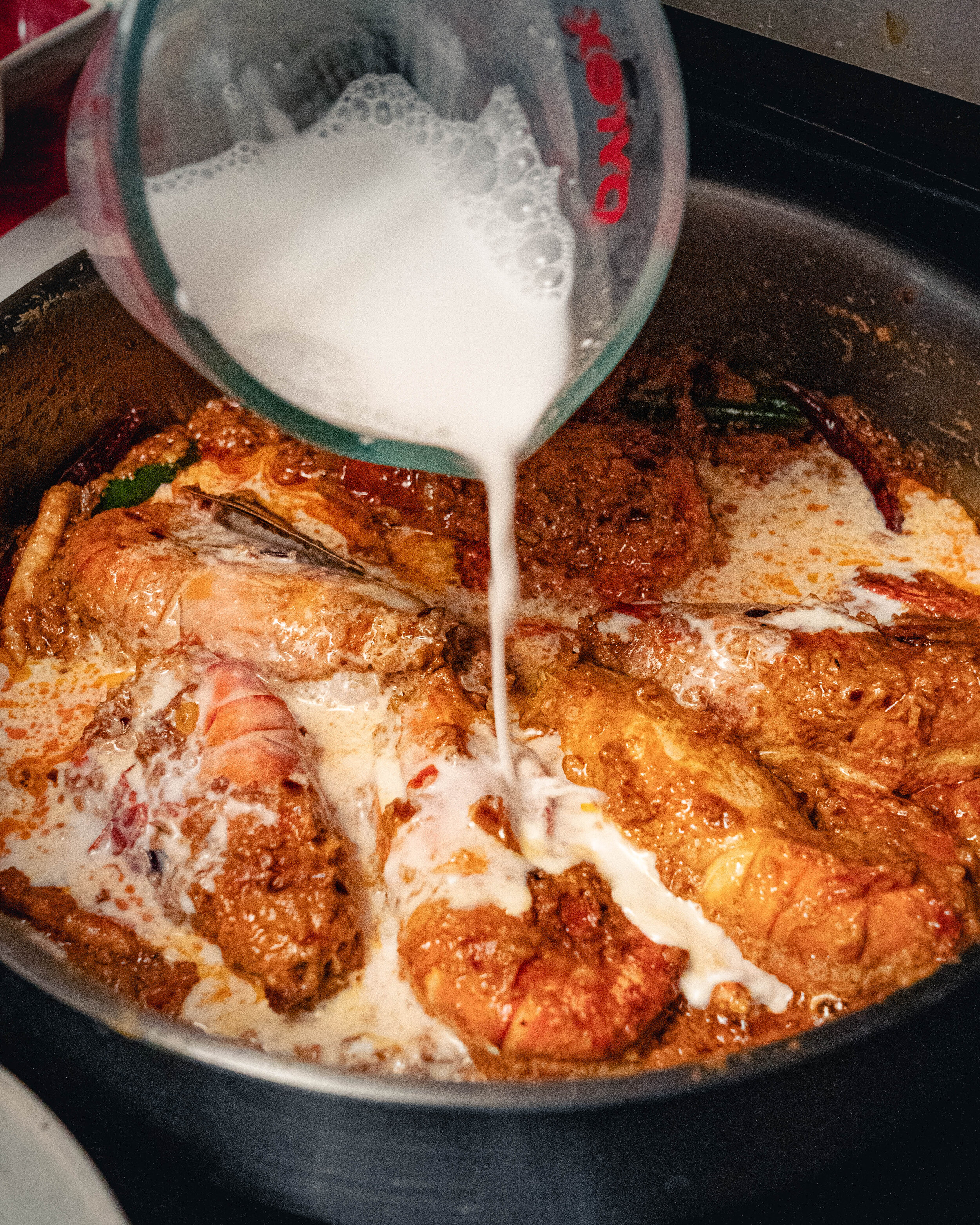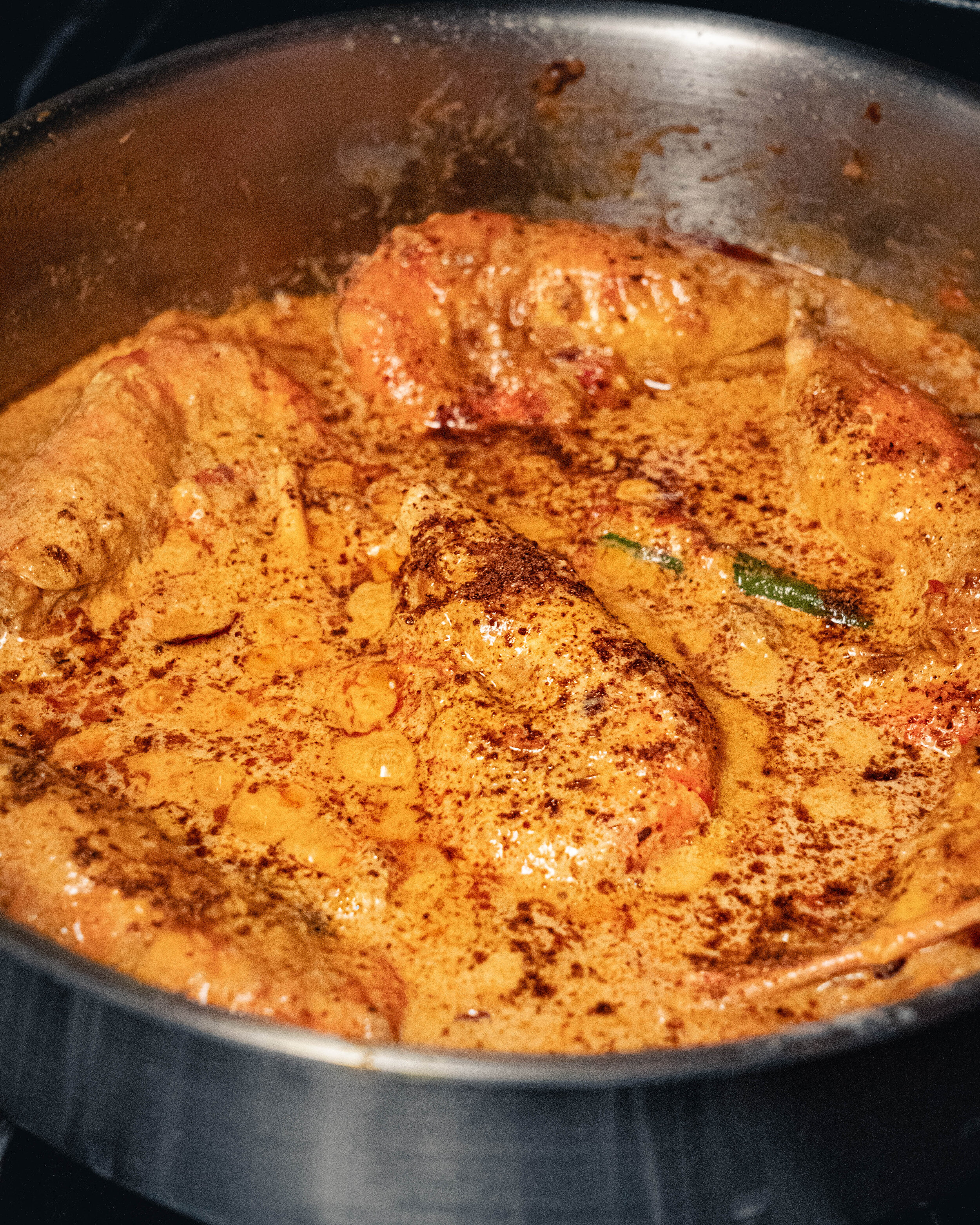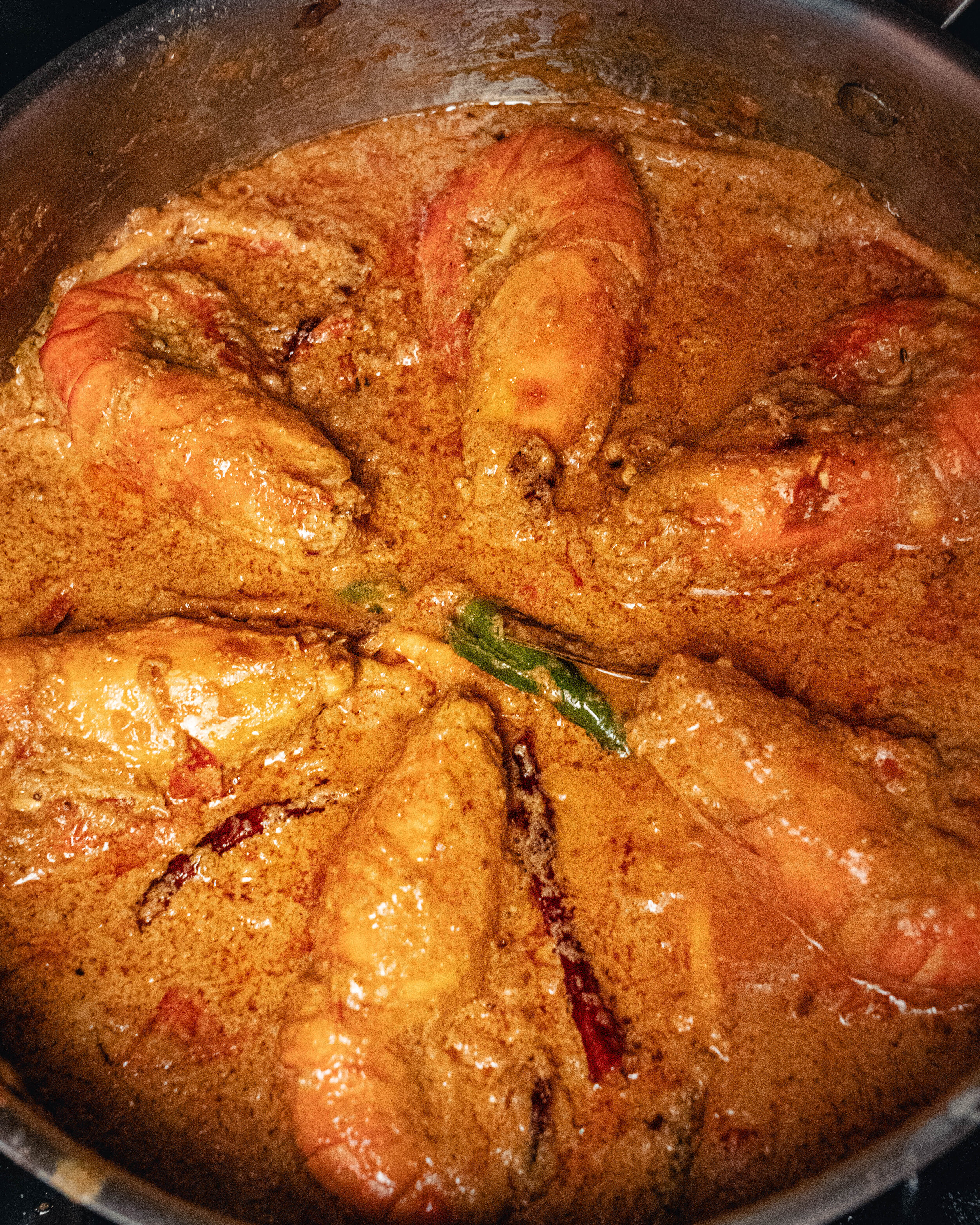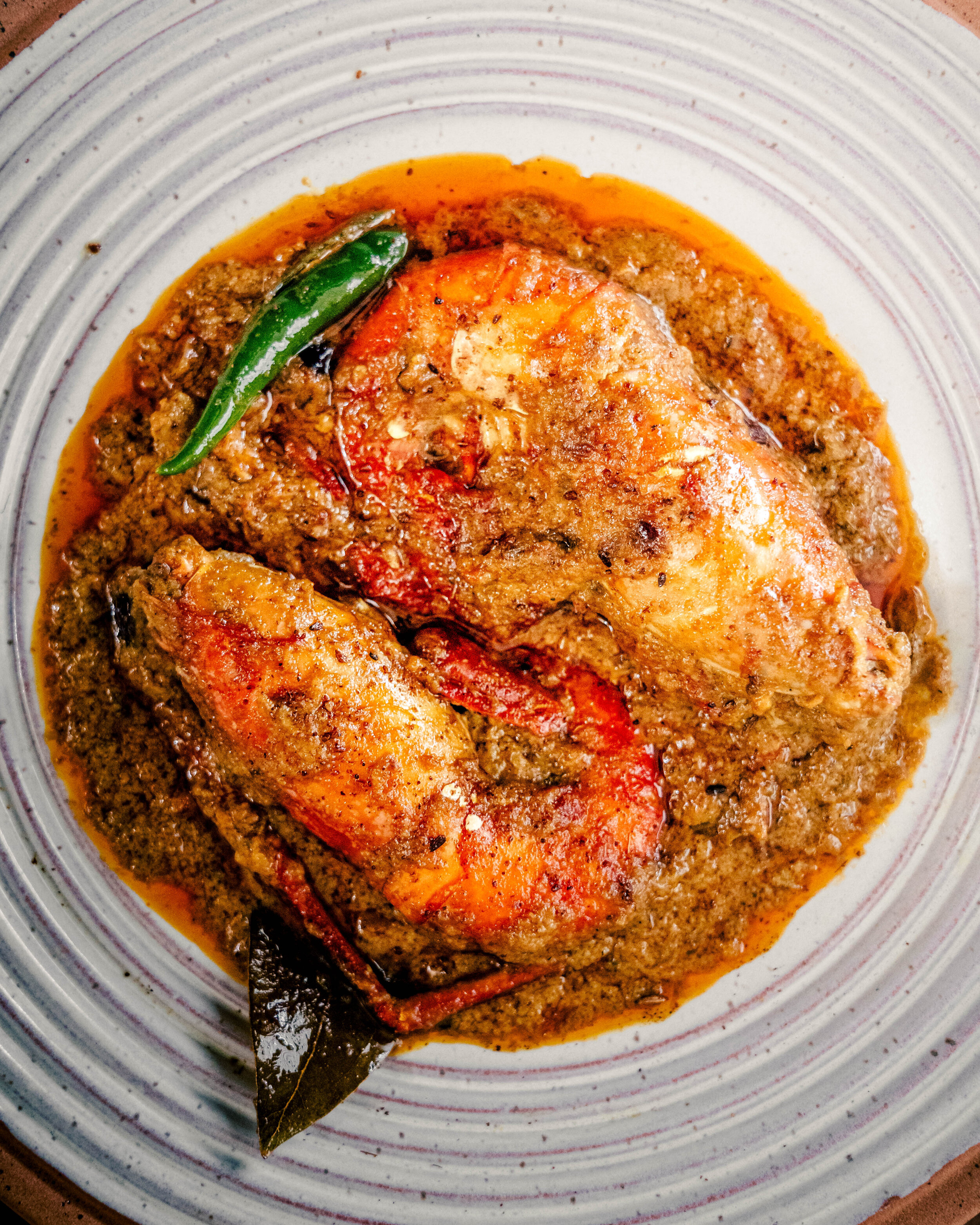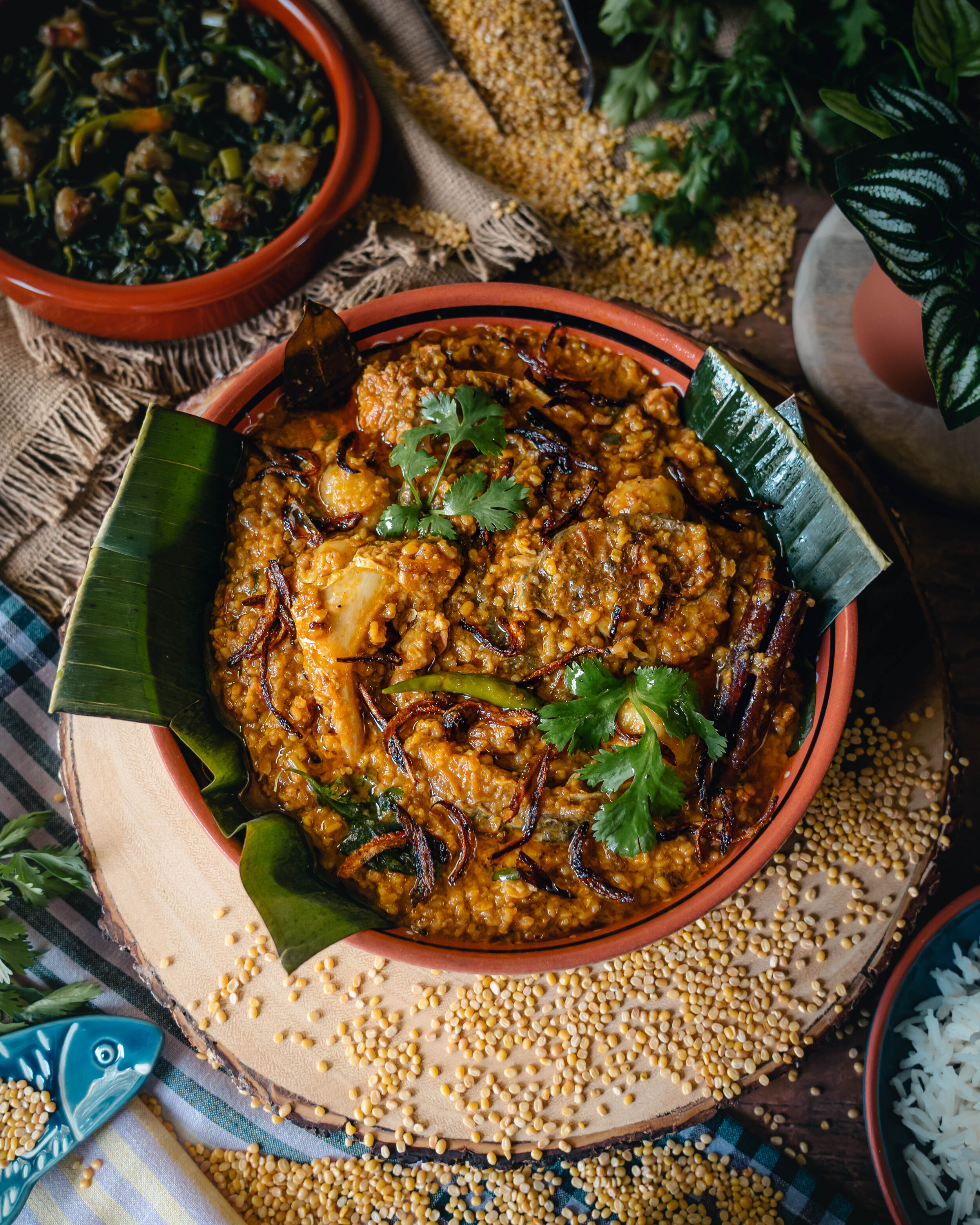Chingri Malaikari
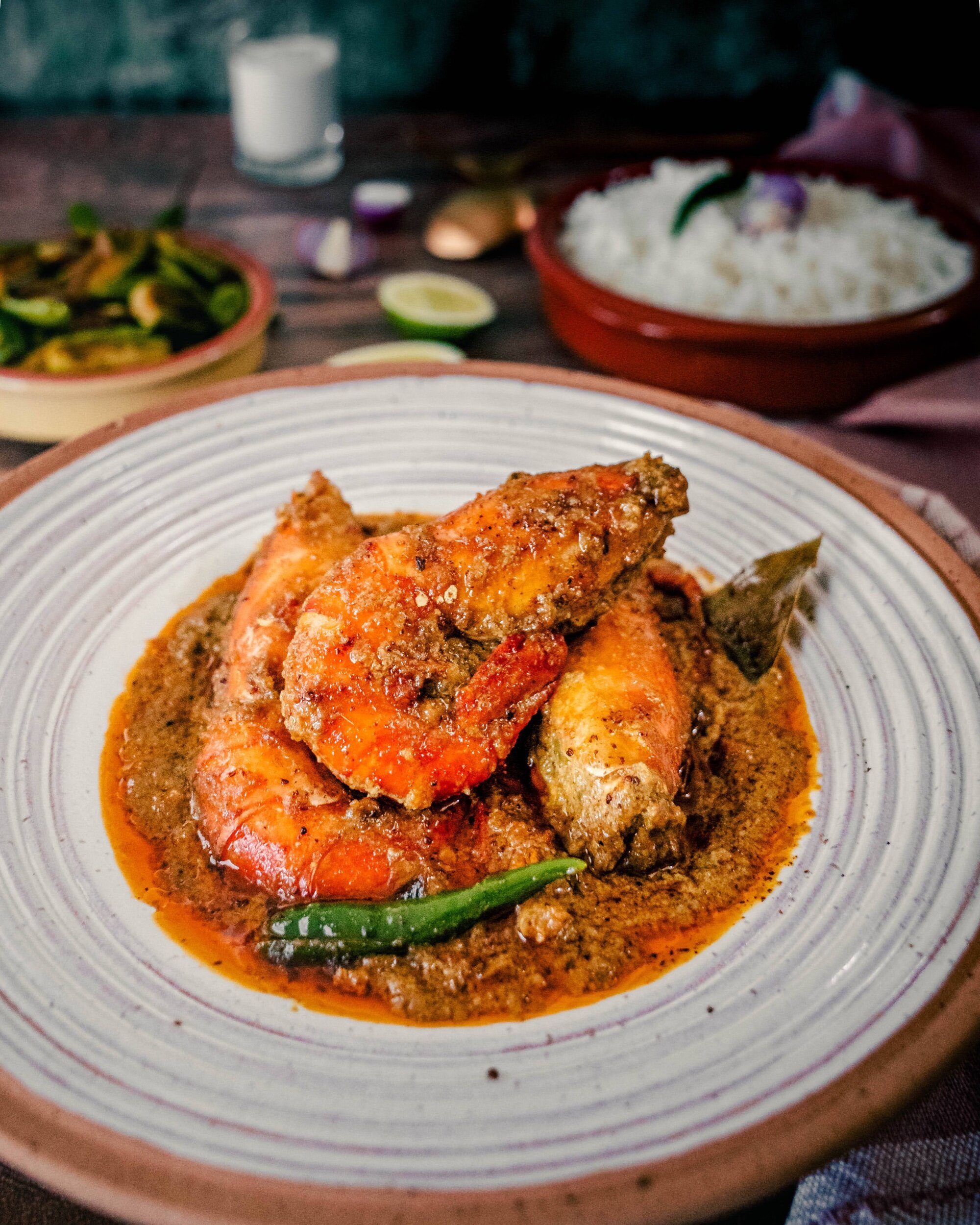
Giant freshwater prawns simmering in a rich and creamy coconut gravy — this dish is very near and dear to every Bengali’s heart. The spice is drastically mellowed down with a combination of coconut cream and coconut milk, along with the sweetness of the prawns. It’s a great way to introduce yourself to Bengali cuisine since this dish isn’t as hot and spicy like typical Bangladeshi food. Chingri Malaikari is so creamy and flavorful, all you need is a side of Gorom Bhat (steamed rice) to enjoy this delicacy.
If we are discussing a potential menu for a Big Bengali feast, Chingri Malaikari is a must. Whether it is Bengali New Year celebration like Pohela Boishakh or a special celebratory dinner like Paan-Chini, an intimate engagement ceremony between the bride and groom's families, Chingri Malaikari will usually grace the table to mark the special occasions. The love us Bengalis have for fish is an understatement and along with the Hilsa fish, prawn is a signature ingredient in Bengali and Bangladeshi cuisine.
Origin
There is always an ongoing debate about the origin of the dish. My theory is that this dish is most likely so ancient that no one knows exactly how it came to be. There are two running theories and it is generally an attempt at breaking down the linguistic elements of the name of the dish: Chingri Malaikari, where the word “malai” can have two different meanings.
Theory #1 | Malai as in Cream
The word “Malai” in the Indian subcontinent means clotted cream. It’s a major ingredient in creating most desserts, cheese as well as a lot of savory dishes. Some people say the name “Malaikari” has to do with the creamy texture of the dish, which is due to the presence of the rich coconut gravy made from coconut cream and coconut milk. When you break it down, the word “malai” and “kari” directly translates to “cream curry”. There isn’t a whole lot of basis to this theory other than the assumption the word malai denotes to “coconut cream”, as opposed to it’s traditional meaning of clotted cream made from dairy milk. If you ask me, I do think this one is a bit of a stretch and I do prefer the second theory over this.
Theory #2 | Malai as in Malaysia
The word “Malai” comes from the word “Malay” as in Malaysia and “Malaikari” broken down means “Malaysian Curry”. There is a substantial amount of historical evidence as well as similar dishes in Malaysian cuisine that possibly indicate that Chingri Malaikari was influenced by the land and people of Malay. First, there are two Malaysian dishes that seem to be the predecessors and foreign cousins - Malay Kari Udang, which is coconut prawn curry and Laksa, which is a spicy coconut soup.
Then there is a significant historical record that indicates during the days of the spice routes, traders and sailors from Malaysia and South East Asia used to travel to this part of the Indian subcontinent. This was way before the British empire, Portuguese traders, Dutch settlements or even the Mughal dynasty. We are going as far back as 8th to 12th centuries, the days of the Pala Dynasty leading up to the Chandra Dynasty.
Pala Empire
The Pala Empire was the last Buddhist imperial power that ruled the Indian subcontinent from 8th century to 12th century. The Pala period is regarded as one of Bengal's golden ages. It was the largest Bengali empire that was known to ancient and classical India. They had extensive trade as well as influence in Southeast Asia. This can be seen in the sculptures and architectural style of present-day Malay Peninsula, Java and Sumatra.
Fun Fact: Somapura Mahavira in Paharpur, Bangladesh built during the reign of the Pala Empire is the greatest ancient Buddhist monastery in the Indian subcontinent and now a UNESCO World Heritage Site.
Chandra Empire
After the Pala came the Chandra dynasty which ruled southeastern Bengal and Arakan (Present day Myanmar) between the 10th and 11th centuries. The dynasty's realm was a bridge between India and Southeast Asia. During this period, the port of Chittagong developed banking and shipping industries.
Fun Fact: Mainamati in Comilla, Bangladesh is an archaeological site that was once considered a religious center as well as a huge ancient Buddhist settlements built by the Chandra Dynasty.
Malay merchants and traders played an essential and significant role since the ancient times to the early modern history of trade and commerce between the Indian subcontinent and Southeast Asia. During the silk road trade, the region of Bengal was a central location since that’s where many trading ports existed. The pattern of trade across these regions were very structured and occurred at various scales, with auxiliary points facilitating major centers. One trading route in particular was the straits of Malacca which were trading waterways in Malaysia linking regions in the west of the Bay of Bengal, which also bordered on the South China Sea and further up north. These trade links were accompanied by a wider exchange of ideas, cultures, languages, and in this case cuisines.
There is a huge South Asian influence in Southeast Asian cuisine, which I have discussed previously in our Thailand series. Similarly, there is a huge Southeast Asian influence in South Asian cuisine, that is particularly noticeable in our Bengali dishes. All of these historical evidences as well as the similar usage in ingredients indicate that a dish like Chingri Malaikari or Prawn Malay Curry is a result of Bengalis being influenced by Malaysian cuisine introduced by sailors and traders which was adapted into our fod culture, as per our taste. And that this is a pretty old, albeit ancient recipe going back almost 3,000 years.
Types of Prawn
In Bengali language the word Chingri is used interchangeably for both prawn and shrimp. When it comes to cooking malai kari, traditionally two kinds of prawns are used but one is generally preferred over the other.
Golda Chingri | Freshwater Jumbo Prawns
Freshwater prawns are giant river prawns and local to Bangladesh, India and South East Asia. They have large head, sometimes even larger than the body itself. The head is filled with lots of tomalley (orange delicious bits) and as it’s cooked the flavour melts into the oil. The flesh of the freshwater prawns are similar to lobster, firmer in texture and sweeter in flavor.
Bagda Chingri | Tiger Prawns
Tiger prawns are also local to South East Asian countries. These types of prawns usually inhabit salt and brackish fresh water, and are mostly found on shallow sea-floors. They are also large and incredibly flavour, with moist, firm flesh but more of a medium flavour, and not as sweet as the freshwater prawns. Tiger prawns also have distinctive grey, blue or black stripes that turn red when cooked.
The consensus among Bengalis is that Golda Chingri as in Freshwater Prawns make better Chingri Malai Kari than Bagda Chingri as in Tiger prawn. The sweetness of the freshwater prawns meld well with the creamy and slightly spicy gravy of this dish.
Personal Tidbits
Growing up this was one of my absolute favorite Bengali dishes and my mom always made sure it graced the dinner table for every celebratory feasts at home. The very first time, my husband came over for dinner, my dad spent a better part of the day going to all the local fish markets searching for Golda Chingri, the biggest freshwater prawns because “his son-in-law was coming over”. My parents put together an elaborate affaire and my mom’s special Prawn Malaikari was one of the many celebratory dishes.
There is a term for this occasion called “Jamai Ador” or “Jamai Shoshthi” in our culture which can loosely translate to “Son-in-law’s Treat”. It’s a ritualistic feast where the Bengali son-in-law eats at his wife’s family home for the first time and samples a variety of dishes that is cooked and served only for him. Truth be told, I do not know about any other culture in the world, which celebrates their son-in-laws or “Jamais” with such fanfare and gluttony. Trust me, Bengali son-in-laws are pampered a lot. And as I said before, Chingri Malaikari is a beloved delicacy and always a must during any Bengali and Bangladeshi feasts.
Recipe — Chingri Malai Kari
Serves: 3-6
Chingri Malai Kari aka Prawn Malay Curry is absolutely delicious and one of my favorite curries growing up. This is a variation of the Prawn Curry my mother makes which almost always graces the dinner table anytime there is a special occasion. And now you have one of our family recipes!
For this recipe, it’s best to use freshwater prawns or tiger prawns - the bigger the better. When cooking with prawn, I highly recommend keeping the shell on because that’s where all the flavors are imparted from, especially the head. And also, it just maintains the integrity of this traditional Bengali recipe, this is how we eat it. And if you don’t, you are missing out, that’s what I tell my picky eater husband. If you are not able to find prawns at your local grocers, the biggest shrimp will also work. I went with 6 giant freshwater prawns but if you choose shrimp, about a pound will do. It’s very common to substitute big shrimps instead of prawns which can be difficult to find unless there is a fish market or an Asian grocery store near you.
Preparing the Shrimp
Freshwater Prawn or Tiger Prawn - 6 qty - 1 lbs
Clean and devein the prawns. Snip off all the little legs and the antennas, discard them. If the prawn came with two giant legs (sometimes they will have blue tinge to them), snip them off and keep them, there's little shrimpy meat inside just like crab and lobster legs. Using a pair of scissors, split open the shell from it’s back and remove the black vein that runs along it’s back. Prawns have a beak on top of their head, snip that off with the scissor and remove the dark sack inside it’s head. But be careful not to remove the orange bits, which is the prawn’s hepatopancreas, aka the digestive organ. In the culinary world it’s called tomalley and it’s deliciously- rich, sweet, shrimpy, and briny. Once you have pulled all the guts and nasty bits out, wash the prawn well and pat them dry.
Now that I have either disgusted you or made you salivate, let’s cook one of our favorite crustaceans.
Salt - 1 tsp
Turmeric - ½ tsp
Mustard Oil - 1 tbsp
In a mixing bowl, combine salt, turmeric and mustard oil. Add the cleaned prawn and gently massage the marinade in. Set aside for half an hour.
Why use oil in the marinade?
Traditionally mustard oil is used to cook the entire dish but I didn’t want it to be too pungent so I decided to only marinate with mustard oil - giving it a subtle pungent kick. It’s important to use fat/oil in a marinade because it helps transfer fat-soluble flavors onto the meat and also helps retain moisture. Fats also help round out flavor profiles such as the sweetness of the prawn and keep sharp or acidic flavors from dominating.
Vegetable Oil - 2 tbsp
Heat up oil in a large skillet over medium-high heat. Once the oil is hot, sear the prawn on each side for no more than 30 seconds. We are not fully cooking the prawn right now, just developing the flavors from the shell. The longer you cook prawns and shrimps the tougher the flesh becomes, so remove them from the heat immediately and set aside.
Preparing the Gravy
Ghee - 1 tsp
Bay leaf - 2
Dried Red Chili - 2
Cinnamon - 2 barks
Cardamom - 3
In the same skillet, heat up the ghee along with the leftover oil. Once the ghee has melted, bloom the whole spices - bay leaf, cinnamon, cardamom and dried red chilies, making sure not to burn them.
Onion Paste - 1/2 cup
Cane Sugar or Brown Sugar - 1 tsp
Garlic Paste - 1 tsp
Ginger Paste - 1 tsp
Add the onion paste and the sugar, then stir fry until it turns to a translucent color, about 8-10 minutes. The sugar enhances the flavor of the onion as well as helps it caramelize. Add the ginger-garlic paste and continue to sauté for another 5 minutes.
Tomato - ½ cup, chopped
Turmeric - ½ tsp
Red Chili Powder - 1-2 tsp, depends on how spicy you like it
Cumin - 1 tsp
Salt - 1 tsp
Once the raw smell of the onion-ginger-garlic has completely dissipated, add the chopped tomatoes and combine well. Then add the ground spices - turmeric, red chili powder, cumin, as well as salt. Continue sautéing until the water has evaporated and the oil starts to separate and pool on the side, like in the picture.
Green Chilies - 4, lightly bruised
Coconut Cream - ½ cup
Reduce the heat to medium-low. Add the green chilies and coconut cream and combine well. Let the gravy reduce just slightly, where it becomes a little thicker.
Bringing It All Together
Add the prawn that was set aside, along with all the shrimpy juice - it’s drippings back into the pan, coat them well with the gravy. Sautee for a couple of minutes making sure not to burn the bottom - allow the gravy to infuse with the prawn, where they start to absorb all the flavors of the aromatics and spices inside as it cooks. Remember we only seared the outside to develop flavors but the inside is still slightly uncooked.
Coconut Milk - ½ cup
Once the prawn is well-coated, add the coconut milk and combine everything well. Bring down the heat to low and allow the prawn to bubble gently in the gravy for another 5 to 8 minutes.
Garam Masala - 1 tsp
Roasted Cumin Powder - 1 tsp
When the gravy is to your liking, depends on how thick or thin you like the gravy and the prawn is just perfectly cooked (do not overcook). At this point taste for salt and add more if necessary. Top it off with garam masala and roasted cumin powder, combine everything one more time and turn off the heat. You may garnish the prawn with more roasted cumin powder and green chilies, like I have before serving.
Enjoy it with a steaming plate of rice of your choice. Bangladeshis usually don’t eat Basmati unless we are cooking Biryanis and Mughal based dishes. Usually we eat short to medium grain rice and they are of Bangladeshi varieties. Calrose, Jasmine and Parboiled rice are similar alternatives but Basmati works just as well, and so does brown rice!
Previously we have showcased a few different series on Bangladesh — Pohela Boishakh (Bengali New Year), Bangladeshi Desserts and Bangladeshi Street Food. This time our series is called “Return to our Roots”, where I will be showcasing Bengali recipes from my childhood and variants of my mother’s cooking. And I know I have said it before but gosh, nothing in the world comes close to my mother, grandmother and aunts cooking. I really truly believe the ability to understand and balance flavors runs in our genes and being able to cook well is a skill I inherited from all the women in my family.



